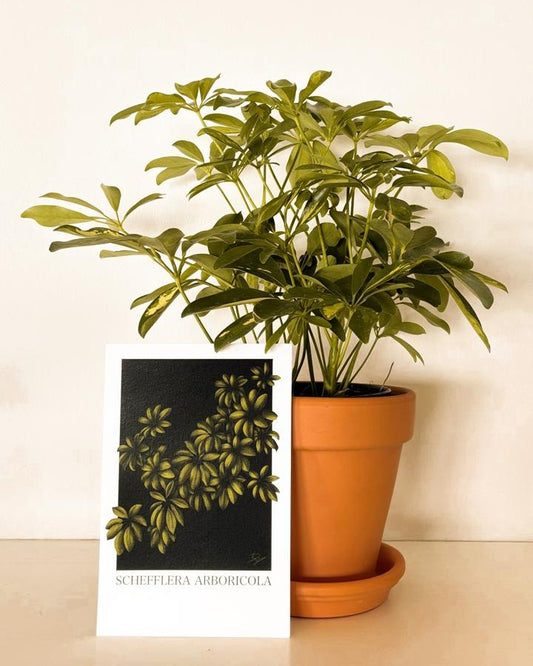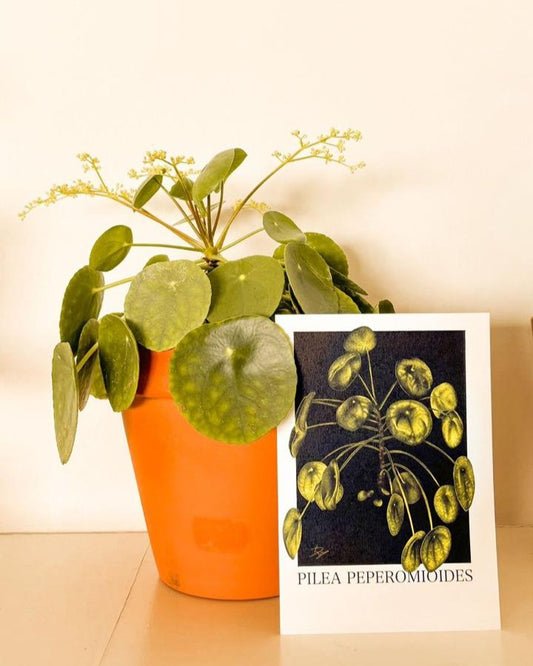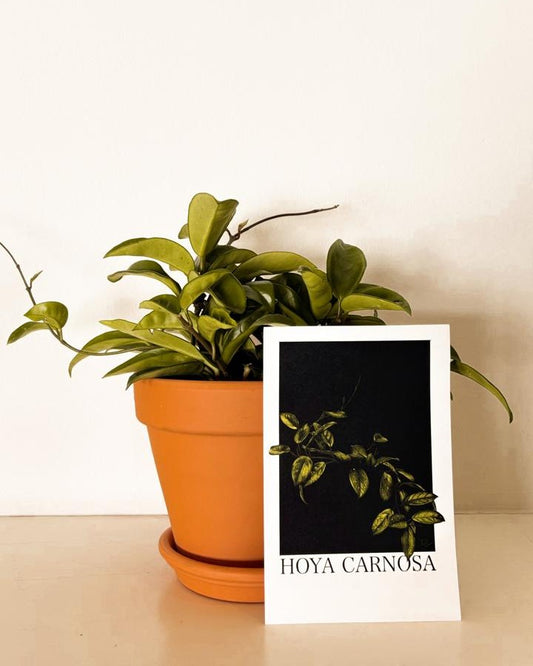The Begonia maculata, or Polka Dot Begonia, is a plant full of striking contrasts in every aspect—from its bold foliage to its distinct care needs. This plant draws attention from houseplant enthusiasts of all levels—and how could it not, with its striking dotted foliage and deep maroon shades that looks almost too perfect to be real?
This is a plant that came with a bit of a learning curve for me (the most rewarding ones usually do!). But finally, after my third attempt at keeping a Begonia maculata alive, I feel ready (and qualified!) to write a blog post about it.
Spoiler alert: This is not one of those plants that thrive on neglect. If you're looking for something low-maintenance and beginner-friendly, this isn't the plant for you.
Botanical Name |
Begonia maculata |
Plant Family |
Begoniaceae |
Common Name |
Polka dot Begonia |
Size |
Up to 1.m tall (indoors) |
Soil |
Well-dranining, but moist |
Mother Country |
Southeastern Brazil |
Toxicity |
Toxic to pets and humans |
Begonia Maculata Care Guide

Sure, the Begonia maculata has a bit of a reputation for being fussy, but once you understand her needs, she’s surprisingly easy to keep happy. Here’s how to care for this botanical wonder.
Light Requirements
Like most tropical houseplants, bright, indirect light is the sweet spot. Keep its natural habitat in mind when choosing a location: this plant naturally grows under dappled sunlight beneath the canopies of lush Brazilian trees. So direct sun is a no-go—but neither is total shade.
Watering Routine
I learned the hard way that this begonia is a thirsty girl. It likes its soil to stay consistently moist, but never waterlogged. I've found that the best way to manage this is with a self-watering system. I personally use Blumat self-watering cones, which slowly release water as the plant needs it.
Humidity & Temperature
This tropical beauty loves humidity and hates the cold. Ideally, keep temperatures between 18–24°C (65–75°F). Drafty windows and air conditioners? Hard pass.
Humidity levels of 50% and up are ideal. If you live in a dry area, I’d recommend investing in a humidifier. You’ll know the humidity is too low when the leaf edges start turning brown and crispy.
Soil & Potting Mix
The key phrase here? Moisture retention. While many tropical houseplants prefer chunky, airy soil, the Begonia maculata likes soil that holds onto moisture without suffocating its roots.
Use a high-quality indoor potting mix and add a bit of perlite for drainage—just enough to prevent soggy roots without drying the soil out too quickly.
Fertilizer Needs
Like most plants, the Begonia maculata is a seasonal grower, pushing out new leaves in spring and summer (and occasionally blooming with dainty flowers!).
Feed every 2–4 weeks during spring and summer with a good-quality liquid fertilizer. Pause fertilizing during fall and winter.
TIP: Always water your plant before fertilizing, even if it’s water-soluble!
Begonia Maculata Common Issues

Brown, Crispy Leaf Edges
Likely caused by low humidity or underwatering. Use a humidifier and don’t let the soil dry out completely between waterings.
Yellow Leaves
Ugh—this one's tricky. Yellowing can be caused by overwatering, underwatering, poor drainage, insufficient light, or even root rot.
Start by checking the roots. Healthy roots should be white, not brown or mushy. Next, make sure the pot has good drainage and that the soil isn’t waterlogged. Finally, try moving the plant to a brighter spot with indirect light.
Pests
Begonia maculata can fall victim to pests like spider mites, mealybugs, and fungus gnats—but I’ve personally never had issues.
Still, prevention is key, kids! Check leaves regularly, wipe them down, and treat with neem oil or insecticidal soap now and then.
Wilting
Droopy, lifeless leaves? Root rot or soggy soil is likely the culprit. Take the plant out of its pot, trim off any mushy roots, and repot in fresh, airy soil with good drainage.
Leggy Growth
If the stems look sparse and stretched, it’s usually due to inadequate light. The plant is stretching toward a light source and sacrificing leaf production.
Move it to a brighter spot with indirect light, and rotate it regularly for even growth.
Powdery Mildew
I’ve dealt with this one before (RIP to that Begonia). It looks like white or grey fuzzy spots on the leaves, usually caused by poor air circulation, cool temps, and high humidity—or water sitting on the leaves.
Remove any infected leaves, treat the rest of the plant with a fungicide, and keep it isolated while monitoring closely.
Propagating Your Begonia Maculata

Begonias are super rewarding to propagate. There are two main methods: water propagation and soil propagation.
Water Propagation
This is my favorite—simple, visual, and fun to watch.
- Choose a healthy stem with at least one node (that little bump where leaves or roots grow from).
- Snip just below a node using sterilized scissors.
- Remove the lower leaves, leaving at least one or two at the top.
- Place the cutting in water, making sure the node is submerged.
- Put the jar in bright, indirect light (not direct sun!).
- Change the water every few days to prevent murk and rot.
- Wait for roots to grow—usually within 2–4 weeks.
Once the roots are a few centimeters long, you can transfer it to soil, or leave it in water indefinitely if that’s your vibe. Just remember that plants do need the nutrients that soil provide, so you'll have to feed it regularly with plant food.
Soil Propagation
Some people prefer rooting directly in soil. It’s a bit riskier because you can’t track root development, but it works.
- Follow the same cutting process as above.
- Dip the cut end in rooting hormone (optional, but helpful).
- Stick it into a well-draining potting mix.
- Cover with a clear plastic bag or dome to create a mini greenhouse (don’t let the leaves touch the plastic).
- Place in bright, indirect light and keep the soil slightly moist, not soggy.
In 2–3 weeks, gently tug on the cutting—if you feel resistance, roots are forming!
Propagation Tips
- Spring or summer is the best time to propagate.
- Propagation works best when the mother plant is healthy and not stressed.
- You can propagate multiple cuttings in one jar—just make sure they’re not too crowded.
- If your cutting wilts dramatically in soil, don’t panic—it might bounce back once the roots catch up.
Begonia Maculata Blooms: A Sweet Surprise

As if this plant isn't striking enough, it can even produce dainty little flowers when given the right care. Such an overachiever! The Begonia Maculata produces delicate, small white or pale pink flowers that typically appear during the spring and summer months. The blooms grow in little clusters that are enhanced by their subtle fragrance, adding a soft contrast to the bold foliage.
For the best chance of blooms, ensure the plant receives bright, indirect light and is properly cared for throughout its growing season. During the winter months, when the plant is resting, blooms are unlikely.
If you're hoping for blooms, consider reducing the amount of fertilizer you use. Fertilizers, especially those high in nitrogen, tend to encourage more foliage growth rather than flowering. By cutting back, you can help shift the plant's energy toward producing those dainty blooms instead.
Styling the Begonia Maculata: Let It Be the Main Character

Let’s be honest—this foliage is the moment. You can style this plant in countless ways, but here are my favorites:
Planter Pairings
Usually, I gravitate toward terracotta pots for their timeless, earthy vibe. But with Begonia maculata’s dramatic foliage, I like to let her do the talking. And, to me at least, the orange terracotta clashes with the maroon tones of the leaves in a way that makes me uncomfortable.
I prefer dark black or charcoal planters that visually disappear beneath the plant, letting the speckled leaves steal the show. That said, white or silvery pots also work beautifully to make those iconic dots pop.
Where to Place The Begonia Maculata for Maximum Impact
I love placing fuller, rounder maculatas in the center of a dining table—it’s an instant conversation piece. I rotate mine frequently to keep its shape.
They also look stunning on a console table against a wall, almost like botanical artwork.
Mixing the Begonia Maculata with Other Plants
When pairing the Begonia maculata with other plants, I like to juxtapose it with plants that are a bit more minimalistic when it comes to their foliage (the introverts of the plant world). Plants like your Monstera, peace lily, or most philodendrons work well next to the Begonia maculata.
I’d steer clear of pairing it with plants that have intricate leaf designs like Philodendron Birkin, Scindapsus, and the like.

I hope that after reading this you now feel equipped to embrace the gentle yet powerful beauty of this striking plant. Let me know in the comments below if you have any additional questions, and I will do my absolute best to answer them!
Frequintly Asked Questions (FAQ's)
Do Begonia Maculata like sun or shade?
Begonias thrive in bright, indirect light and are sensitive to harsh sun, which can scorch their delicate leaves.
Why are the leaves falling off my Begonia maculata?
Excessive leaf drop can signal issues such as overwatering, underwatering, root rot, or exposure to cold drafts. However, if only a few leaves fall off occasionally, it’s usually nothing to worry about.
Should I mist my Begonia maculata?
Definitely not. Begonias dislike having their leaves wet, and misting does little to raise humidity levels effectively. If you’re looking to boost humidity for your Begonia maculata, using a humidifier is your best bet.





